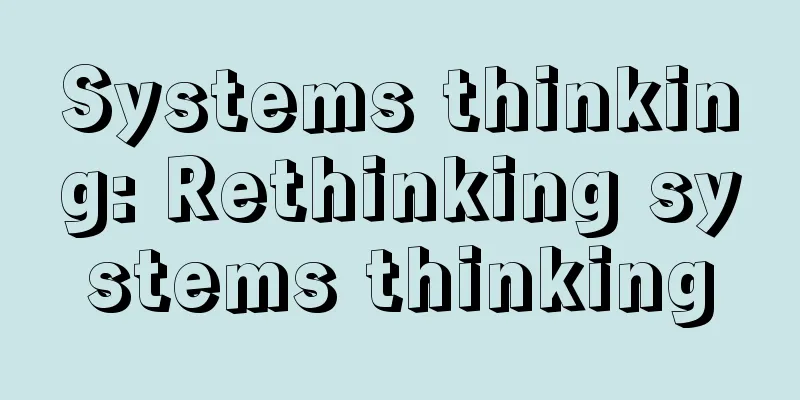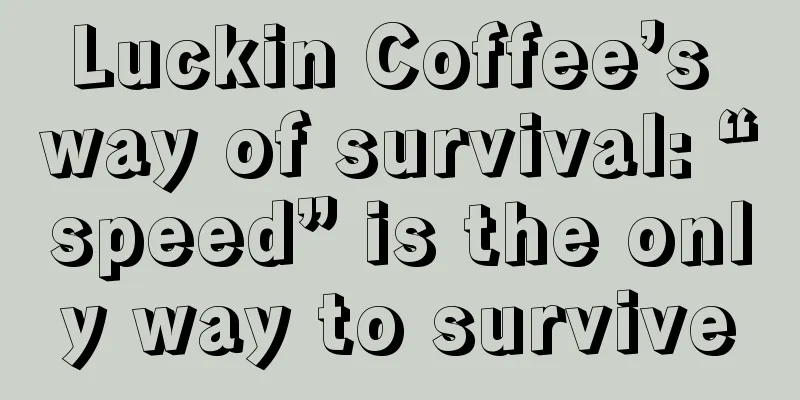Systems thinking: Rethinking systems thinking

I found that only by realizing the importance of systems thinking can you understand why it is so important to embed various useful systems in your life ; in addition, you can also see how bad systems can destroy your life. It may prevent you from forming a positive cycle. To be honest, I only wrote occasionally a few years ago, and I didn’t expect to become a frequent writer now. In the past, my worst experience was that I didn’t have a writing system. What are the consequences of this carelessness? Low efficiency, few followers, no business. When I treated self-media as a task and a system, I found that it attracted a lot of attention from friends and gradually formed commercialization and other actions. By relying on different systems, we can become a better decision maker and improve efficiency and income; it can also change the way we think (and act) in certain specific areas. Once we understand it thoroughly, we can discover the hidden feedback traps in life and reorganize better methods. Therefore, all these discussions about systems lead to a question: What is systems thinking? Everything around us is a system, and each system is a subsystem of a system. The so-called system thinking means: by understanding the relationship between things, we can better understand how things interact and influence each other, so as to learn how to better control and change these things to benefit ourselves. Simply put, this is a repetitive behavior that will lead to certain predictable results. Admittedly, the concept sounds technical and abstract. You don't have to worry about this. I will try to use simple methods to show you how to see the relationship between things and what thoughts are hindering your progress. Take people as an example: We have all kinds of feelings because many complex systems are at work in our bodies, including the nervous system, immune system, respiratory system, reproductive system, etc. We also have a system called "banner blindness" in our bodies, which ensures that when browsing the web, we consciously ignore the annoying and annoying ads and focus on reading the page itself. Isn’t it interesting? Let's narrow the scope and imagine system thinking as a furniture factory. In the furniture factory, wood is the raw material, and after a series of internal processes, including material input, production, assembly, etc., the final products are tables, chairs, cabinets, etc. The entire operation process is also a system. Indeed, system operation can be understood as a process of input, digestion, and output around a certain goal, which includes three components: elements, connections, and functions or goals. For a furniture factory, the factor is wood, the target is furniture, and the system is the structure within the factory that can achieve production goals. For the human digestive system, food is the input, the system is the gastrointestinal tract, and I won’t talk about the output, as everyone should know it. Another example: a soccer team is a system that consists of multiple elements, such as players, coaches, fields, and balls, which are interconnected by game rules, coaching instructions, player skills, communication between players, and the laws of physics. Every element in the entire system is crucial. Players play key roles in the game, and their skills, physical strength, intelligence and teamwork affect the team's performance ; coaches are responsible for formulating tactics, guiding training and managing players, influencing the team's overall strategy ; the field is the physical environment of the game, and the football is a game prop that affects the outcome. The interrelationships between these elements are complex and critical. The rules of the game stipulate penalties and competition mechanisms; coaches influence the situation in the game through tactical guidance of players; and players cooperate and collaborate with each other to achieve common goals. Team goals may include winning or losing, making money, exercising, having fun, etc. Different goals affect the team's strategy and management methods. For professional football teams, winning games and making money may be the most important goal, which needs to be achieved through signings, training young people, and sponsorship and cooperation. For amateur teams, entertainment and exercise may be more important, and they need to pay attention to the physical health of players. It can be seen that a successful system must achieve consistency between individual goals and the overall goal of the system. Changing any small connection or small goal of the system will change the system, while simply changing the elements will not. However, the most common problem in goal achievement is goal misalignment (Seeking the Wrong Goal). What does it mean? When achieving a goal, the attention and resources are placed in the wrong place, resulting in failure to achieve the desired results. This may be due to unclear, unreasonable, or unrealistic goal setting, which leads to deviation from the correct direction in the pursuit process. Like: On a personal level, I want to improve my cognitive level. Simply measuring it by the number of books I read is not enough, because the number of books I read does not guarantee an improvement in reading quality and cognitive level. You should make your goals more specific, such as improving negotiation skills, breaking down critical thinking barriers, etc. In this way, your goal is no longer simply to read a book, but to express yourself better or make decisions more effectively. At the company level, some Series B companies lack marketing teams and annual plans, and rush to hold events simply because other companies are doing so, resulting in a waste of funds and the dilemma of being caught up in the crowd. Some project teams set ROIs too idealistically, but ignore project risk assessment and resource planning, resulting in failure to achieve the desired results. It is true that misaligned goals can have negative effects on individuals and companies. Correctly setting and pursuing appropriate goals is an important prerequisite for achieving desired results. Spend as much time as possible to figure out what you want. We can clearly see that the overall goal is an important indicator to guide the operation of the system. So, based on the goal operation, what is the most important connection between elements? 1. Linking circles and feedback loopsWhat is the Causal Loop Diagram? It refers to who is related to what you do, and whether they play a positive feedback role for you. How to construct an association circle? There are two steps: First, you can draw a circle on paper to draw a correlation ring, write the key elements of the system you want to understand into it, and meet three criteria: it is important for system change, has an enhancing and regulating effect, and can be described in one phrase. Second, write down the key elements in the circle and find the cause-effect relationship between them, represented by arrows. By analyzing these relationships, you can make hypotheses and find the network of relationships that may form a loop, which is called a "feedback loop." For example, the residents of a village have been facing a food shortage problem. They know that this is due to factors such as poor soil, backward planting techniques and inconvenient transportation. To solve this problem, the villagers introduced new agricultural technologies, planting methods, and tried new ways to transport agricultural products. Now, let's draw a circle of association to understand this problem more deeply. Based on the above background, five key factors can be identified. Next, we look for and label the cause-effect relationships between them; we find that poor land leads to food shortages because crops grow poorly. Poor planting technology is also one of the reasons for poor land because there are no suitable farming and fertilization methods. To solve this problem, villagers have introduced new agricultural technologies and planting methods to improve land quality and increase crop yields. However, inconvenient transportation has made it difficult to transport agricultural products, making it impossible to deliver agricultural products to the market quickly, thus affecting income and sales, which may limit the extent to which villagers adopt new technologies. This forms a feedback loop: poor land leads to food shortages, and the introduction of new technologies can improve land quality and thus reduce food shortages, but inconvenient transportation may limit the effectiveness of new technologies, thereby affecting food supply. By drawing a complete circle of connections and identifying feedback loops, we can better understand the operating mechanism of the entire agricultural ecosystem, so that we can take targeted measures to help things themselves make the necessary changes. What is a feedback loop? As I understand it, it is a regulatory mechanism that inhibits further changes in a certain direction. Its existence seeks balance and stability in the system. It has five dimensions: positive feedback, negative feedback, automatic adjustment, amplification effect, and delayed effect, including three important components: expected level, actual level, and the gap between the two. Take autoregulation: When a feedback loop identifies a gap, it triggers an error correction to adjust the actual level to the desired state. The key to identifying and understanding a particular regulation loop is to discover the desired level, which is sometimes not intuitive and requires deeper exploration. For example, a thermostat at home can detect the indoor temperature (actual level). When the indoor temperature is steadily lower or higher than a set value (desired level), it will automatically heat or cool the room to keep it within the set range. There are many more examples, like an automatic water heater, where when boiling water is placed next to it, it slowly cools down from the actual high temperature (the actual level) until it reaches a temperature below a certain point, at which point it heats up again to your desired level. Similarly, a fire sprinkler system automatically sprays water if a fire is detected; regulators would not allow a hotel to operate without extensive fire protection measures. Therefore, positive feedback causes the system to change continuously in a certain direction, tending to be unstable or continuously amplified; negative feedback enables the system to respond to external disturbances and maintain stability or restore its initial state through self-regulation. This feedback loop is actually a protection mechanism that can prevent you from being destroyed, but most people ignore the "feedback loop". For example, if you only have one job and no sideline, and you lose your job and have no savings, what should you do? Some things may seem expensive and useless in the short term, but in the long run, we absolutely need to trigger specific systems when emergencies occur. Furthermore, before you lose your job, you must establish a new profit feedback loop to ensure that the system will not collapse instantly after you lose your job. Of course, the system has both an internal mechanism to ensure its integrity and an external integrity. Just like a person, he must have a relationship with the social outside world to maintain a balance in life. In this case, the feedback loop may also be strengthened. 2. Feedback Reinforcement and the Tragedy of the CommonsPositive Feedback simply means that the output of a system's interaction with the outside world produces feedback on the "input within the system", thereby triggering a self-reinforcing cycle. like: When you place a microphone next to a speaker and turn on the speaker, the speaker will amplify the sound captured by the microphone, and then amplify the sound captured by the microphone again, forming a positive cycle. As the cycle continues to increase, the sound will become louder and louder until a sharp noise appears. or: Traffic congestion is also a positive feedback loop. When more vehicles on the road cause traffic congestion, vehicles slow down, which leads to more vehicles entering the road, increasing congestion. As the cycle continues, traffic congestion will continue to increase until it reaches saturation. As you can see, adding loops can amplify the impact of a process. Compound interest is a good example. The more money you deposit in a bank account, the more interest you get; the interest also adds to your account balance in the form of cash, so you get even more interest. Have you noticed? All reinforcing loops have two basic characteristics: first, the output of the loop, and second, the input of the next loop. The two variables in the loop reinforce each other. Many people would say, isn’t this a good thing? However, when faced with incorrect feedback, the harder you push the system, the greater the rebound force, which becomes compensatory feedback. The more well-intentioned the intervention, the more it will trigger the negative effect of the system. for example: I decided to get up and run every morning. At first, everything was fine, but as work pressure increased, I began to feel tired, which made it difficult for me to get up in the morning. I often chose to sleep in and missed my running time. As I missed my runs, I realized that my health had declined. To make up for the loss, I decided to add extra exercise time in the evening. However, due to the limited time in the evening, my social and leisure time were affected, which caused me to stay up late and have difficulty waking up the next day, and I missed my morning run again. And many more. The more money you spend and the more loans you take out, the worse off your financial situation will be. Conversely, the more money you invest, the more interest you earn. The more time you waste on pointless social media engagement, the more you will do so, and the less time you will have to spend reading and improving your skills. In other words, facing wrong behavior may lead to unexpected negative effects, which will exacerbate the complexity of the problem. What will this situation cause? First, shifting the burden to the intervenor. To put it bluntly, it is a natural mentality for people to go to the bottom. When you have a problem, instead of facing the problem and finding a solution, you shift the burden to other things. Just like when you are in a bad mood, you smoke and drink. Instead of facing the problem, you "fill the hole" and numb yourself with alcohol to divert your thoughts from the oppressive problem. Second, the Tragedy of the Commons: Pursuing unlimited benefits in a limited system. People like to lock themselves into an ever-expanding system, a hobby, a relationship that initially seems achievable but ultimately hurts us due to limited energy or other factors. Just like, we are so obsessed with promotions and salary increases that we forget that in addition to work, life also includes friends, children, spouses, and the need for rest. At first, one more project does not feel like a big deal, but all the tasks added up become a huge burden. It is true that the integrity outside the system will nest small systems indefinitely, and you cannot control the external system, but the feedback of the external loop may change the "internal system", and the ultimate goal will be eroded, falling into a vicious cycle. You must have heard of the Matthew Effect, that whoever has, more will be given, and he will have an abundance; whoever does not have, even what he has will be taken away. If you do not have a system of continuous positive feedback, it is difficult to form compound interest; how can you establish the mindset of the rich getting richer? Take writing as an example: One group believes that just writing is enough and completely denies the necessity of taking notes; the other group insists on finding the perfect note-taking system, but does not actually take notes during the search process, or frequently changes software and does not form their own "second brain" at all. As someone who has been journaling for nearly 5 years, my advice is to choose a simple note-taking system to keep track of your thoughts. Why? Nowadays, a large amount of content is emerging on social media. Relying solely on brain memory is completely weak memory, which is not a sustainable positive feedback system. Assuming that you can put the content into the notebook library at any time when reading books, materials, and TED, the first step will be successful. The second step is to turn your ideas into “projects and tasks” to do. You must have done a lot of things like collecting things and letting them gather dust. I am no exception and I will soon stop reading them. Assuming that once an idea is set with a deadline, you will think about how to supplement it and when to file it in the document. Its initial operation efficiency may not be friendly, and you need to further optimize the system rhythm, such as content categories, recording key information, and regularly reviewing notes. In this way, complete input and output become a new feedback system. Think about it, right? Take making money for example: Work is the default way to make money. We receive education and from graduation we go into an office or factory and get paid in cash. But unfortunately, apart from working from 9 to 5, no one tells you that life, like a company, is a cash flow game, and you also need to be stable and increase value. Personally, I think there are two parts to building a money-making system. First, find a job. Whether you are interested or not, you must have one. Second, keep learning new knowledge. The so-called knowledge is not a word game, finding useful information on the Internet, but realizing that learning certain content can make you an expert in a specific field. If you take these two steps well, even if you are fired, you can quickly find a good job because you have transferable skills. If you are a boss, these two steps will make you more capable of adapting to new changes. In addition, turning the knowledge you have learned into an intangible asset can bring you additional growth. Therefore, we can see that to establish a sustainable and stable money-making system, what is invested is time, what is output is cash flow, and the system that is optimized in the process is yourself. Take life for example: If you have often been troubled by issues such as fitness and daily routine in the past, then I suggest that you do not use self-discipline and willpower to demand yourself in the future, because these cannot change the system from a deep level. You just need to find out which cause leads to the effect, and then gently push the "cause". The two are positive variables in relationship with each other, and new changes may occur. Just like, many people say that I am used to staying up late because I am not sleepy. So, what causes me to not be sleepy? Is it the daytime state? Or is it because I have been under a lot of mental stress recently and have been constantly tense? This cycle just reinforces the "staying up late". Similarly, some people have mild social phobia. Every time they interact with others, they feel pressure out of nowhere, which causes anxiety and worry during interactions. Have you ever thought about the reasons behind social phobia? Are you not confident? Do you care about appearance? Are you afraid that what you say will be criticized? Find out these potential factors. You don't need to make big changes. Just make slight adjustments to make yourself more relaxed and natural when interacting with others. This will produce different circuit reinforcements. Take investment for example: How do you manage your income? It's no exaggeration to say that when you think about managing your money, you've probably wasted a lot of money on unnecessary expenses. Instead of leaving your money in the bank, choose smarter ways to use it. I use money according to the 3737 principle, that is, 30% of the total income is for consumption and 70% is for investment. The 70% is a whole, 30% is for stable investment and 70% is for risk investment. After the 70% risk is regularly earned, the cycle continues, which is a positive feedback. Many investment strategies and experts make investing too complicated. In fact, you don’t need to know too much investment information. At the beginning, you may need to look at how others build their investment portfolios, choose a stable long-term method, and invest extra funds in a combination of funds or a good company. Thus, the investment system consists of three parts: the first is input: money, the second is output: money, and the third is to establish the system: carefully select the portfolio assets every month. Did you find it? All systems point to one key point, which is to establish positive feedback and stabilize the internal small system when interacting with the outside world. The same is true for business. Only by mastering these can we truly understand "system thinking". In general: blind development will not go far. Change happens from the inside out. If you want to optimize the system, the best way is to focus on the goal, bring external information into the internal, see what changes have taken place internally, find where the feedback loop is unstable, and break through them one by one. Author: Wang Zhiyuan, public account: Wang Zhiyuan Original title: Re-understanding systems thinking |
>>: Who says hot topics are hard to grasp? Three ways to create hot topics and attract attention
Recommend
What is your keyword for 2022?
In a blink of an eye, the balance in 2022 is less ...
AI+Xiaohongshu search, create popular notes at low cost!
How to output notes efficiently? AI + Xiaohongshu ...
Cheap rings are selling like hot cakes on TikTok!
Is it profitable to sell cheap rings on Douyin? Ho...
Is the total balance displayed in cross-border e-commerce stores in US dollars?
In the field of cross-border e-commerce, many sell...
WeChat has been iterating quite fast in the past six months
This article deeply analyzes the changes in WeChat...
Taking "Bai Xiao T" as an example, briefly analyzing the logic of good business
What is business? What is a good business? How to ...
Brand upgrade: How can brands sell at a higher price and sell more?
Generally speaking, brands are likely to encounter...
Rebirth: I am doing e-commerce operations
This article uses a fictional story to tell how an...
From Haidilao to Pangdonglai, has service become a new marketing trend?
This article tells the reasons why Pang Donglai be...
What does it mean to understand business? Three perspectives on business
The core competency of data analysis is to enable ...
Is it difficult to receive orders from Alibaba International Station? Should we still open an international station?
Everyone should know Alibaba. When you are doing c...
Say goodbye to your “low-energy” self and transform from a “startup dog” to a “startup mad dog”!
Starting a business is a life-or-death game. Many ...
How can merchants increase their private domain traffic rate by using Xiaohongshu?
How can merchants use Xiaohongshu to increase priv...
How can Amazon avoid association? Will Amazon be associated if it uses a mobile network card?
The act of associating Amazon accounts violates th...
The explosion of urban IP: the cultural potential and emotional power behind traffic
From Zibo barbecue to Tianshui spicy hot pot, and ...









